Invented by Barbara A. Swanson, John Dixon Gray, Heyue Zhou, Sorrento Therapeutics Inc
One of the main advantages of antibody therapeutics that target CD47 is their ability to enhance the body’s immune response against cancer cells. By blocking the CD47 protein, these antibodies prevent cancer cells from sending signals that inhibit the immune system’s ability to recognize and destroy them. This approach not only allows the immune system to better identify cancer cells but also promotes the activation of immune cells, such as macrophages, to engulf and eliminate cancer cells.
The potential of CD47-targeting antibodies has been demonstrated in various types of cancer, including leukemia, lymphoma, breast cancer, and solid tumors. In preclinical studies, these antibodies have shown remarkable efficacy in inhibiting tumor growth and metastasis, leading to increased survival rates in animal models. Moreover, CD47-targeting antibodies have been shown to synergize with other cancer therapies, such as chemotherapy and radiation, further enhancing their therapeutic potential.
Several pharmaceutical companies and biotechnology firms have recognized the immense potential of CD47-targeting antibodies and are actively developing and commercializing these therapeutics. Some of the leading players in this market include Trillium Therapeutics, Forty Seven Inc., and Alexo Therapeutics. These companies are conducting clinical trials to evaluate the safety and efficacy of their CD47-targeting antibodies in patients with various types of cancer.
The market for antibody therapeutics that bind CD47 is expected to witness significant growth in the coming years. According to a report by Grand View Research, the global CD47-targeting antibody market is projected to reach a value of USD 5.9 billion by 2027, with a compound annual growth rate (CAGR) of 36.6% from 2020 to 2027. The increasing prevalence of cancer, coupled with the need for more effective and targeted therapies, is driving the demand for CD47-targeting antibodies.
However, like any emerging market, there are challenges that need to be addressed. One of the main challenges is the potential for off-target effects and toxicity associated with CD47-targeting antibodies. As CD47 is expressed on various normal cells, blocking its function may lead to unintended consequences. Therefore, careful evaluation of the safety profile of these therapeutics is crucial to ensure their clinical success.
In conclusion, the market for antibody therapeutics that bind CD47 is witnessing rapid growth, driven by the need for innovative and effective cancer therapies. These antibodies have shown promising results in preclinical and clinical studies, and their ability to enhance the body’s immune response against cancer cells makes them a potential breakthrough in cancer therapy. With ongoing research and development efforts, the future looks promising for CD47-targeting antibodies, offering hope for improved treatment outcomes for patients with cancer and other immune-related diseases.
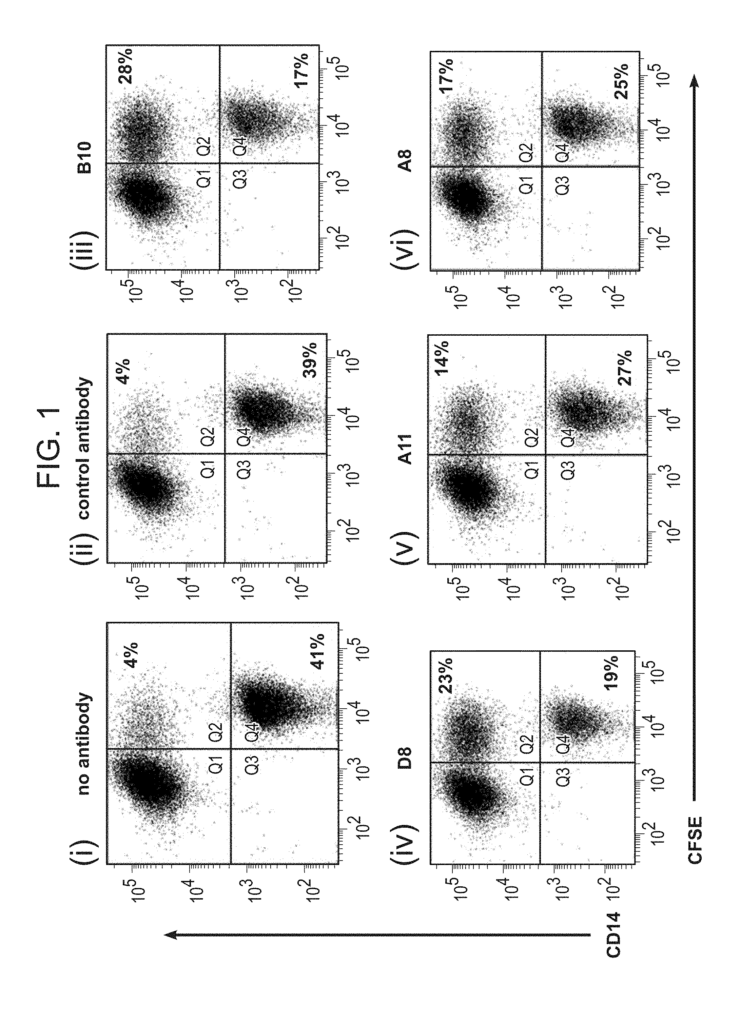
The Sorrento Therapeutics Inc invention works as follows
Compositions and methods related to or derived by anti-CD47 antibody are disclosed. There are also disclosed CD47 antibody fragments, derivatives, and polypeptides that contain these fragments. There are also nucleic acid coding for such antibodies and antibody fragments as well as polypeptides. Cells containing such polynucleotides can be found.
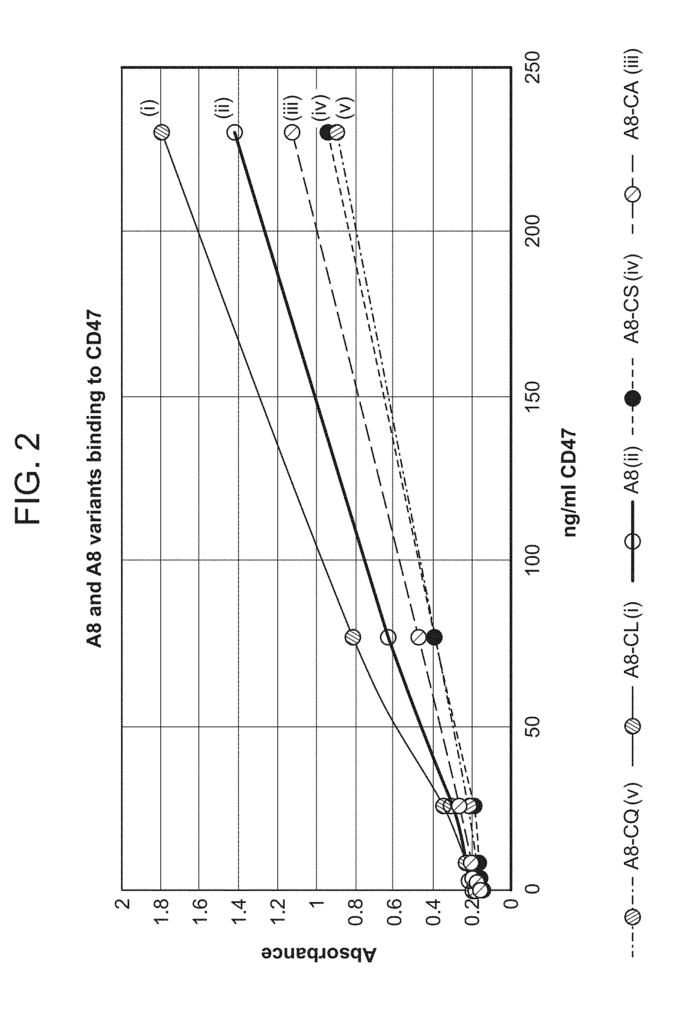
Background for Antibody Therapeutics that Bind CD47
CD47 is also known as integrin associated protein (IAP), ovarian carcinoma antigen OA3, Rh related antigen and MER6. It is a transmembrane multi-spanning receptor that belongs to the immunoglobulin family. CD47 expression or activity has been implicated in a variety of diseases and disorders. There is a need to develop therapies that target CD47. The present disclosure provides fully human antibodies against CD47 that overcome these and other deficiencies of the previous antibodies.
In certain embodiments the present disclosure provides an antibody that is fully human of the IgG type that binds a CD47 with a binding affinity of at least 106M and that has a heavy-chain variable domain sequence which is at least 95 percent identical to the amino acids sequences chosen from the group consisting SEQ ID No. 1, SEQ NO. 7, SEQ NO. SEQ ID No. SEQ ID No. SEQ ID No. SEQ NO. SEQ ID No. SEQ NO. 16, SEQ NO. 16, SEQ ID No. SEQ NO. SEQ ID No. SEQ NO. 5, SEQ NO. SEQ NO. SEQ ID No. SEQ NO. 19: SEQ NO. 20, SEQ NO. 21 SEQ NO: 23, 25 SEQ NO: 26, 26 SEQ NO: 27, 28 SEQ NO 29 and 30 and combinations thereof. In one embodiment of the fully human antibodies, both the heavy chain and the light chain are present. The antibody contains a heavy-chain/light-chain variable domain sequence that is selected from a group consisting SEQ ID No. 1/SEQ NO. 2 (called C47A8 herein), SEQ ID NO. SEQ ID NO. 4 (called C47B10 herein), SEQ ID NO. 1/SEQID NO. 5 (called C47B10-1H4S herein), SEQ ID NO. 1/SEQ NO. 6 (called C47B10-1F6S herein), SEQ ID NO:1/SEQ ID NO:8 (called C47B10-1 herein), SEQ ID NO. 7/SEQ NO. 8 (called C47B10-2A9S herein), SEQ ID NO. 9/SEQ NO. 8 (called C47B10-2B11S herein), SEQ ID NO. 10/SEQ NO. 4 (called C47B10-2B8S herein), SEQ ID NO. 11/SEQ NO. 4 (called C47B10-2C1S herein), SEQ ID NO. 12/SEQ NO. 4 (called C47B10-2B9S herein), SEQ ID NO. 13/SEQ NO. 4 (called 2C4S herein), SEQ ID NO. 14/SEQ NO. 15 (called C47B10-B1C herein), SEQ ID NO. 16/SEQ NO. 15 (called C47B10-C6C herein), SEQ ID NO. 17/SEQ NO. 15 (called C47B10-C3C herein), SEQ ID NO. 18/SEQ NO. 15 (called C47B10-D3C herein), SEQ ID NO. 19/SEQ NO. 15 (called C47B10-C11C herein), SEQ ID NO. 1/SEQ NO. 20 (called C47KD8 herein), SEQ ID NO. 1/SEQ NO. 21 (called C47KD9 herein), SEQ ID NO:1/SEQ ID NO:8 (C47B10-1H4S2), SEQ ID NO. 32/SEQ NO. 15 (C47B10 – C3C), SEQ NO. 1/SEQ I.D. 1/SEQ I.D.
The present disclosure, in one embodiment provides a Fab fragment fully human antibody, with a variable region of a heavy chain, and a different variable region for a light-chain, wherein heavy chain variable sequence is at least 95 % identical to amino acid sequences chosen from the group consisting SEQ ID No. SEQ ID No. SEQ ID No. SEQ ID No. SEQ ID No. SEQ ID No. SEQ NO. SEQ ID No. SEQ NO. 16, SEQ NO. 16, SEQ ID No. 18, SEQ NO: 22, and SEQ NO: 24 and SEQ NO: 32 and combinations thereof and a light-chain variable domain sequence which is at least 95% identical to the amino acid series consisting of SEQ NO. SEQ ID No. SEQ NO. SEQ NO. 6, SEQ NO. SEQ ID No. SEQ ID: 19 SEQ NO. 20, SEQ NO. “21 SEQ NO: 23, 25, 26, 27, 28, 29, and 30, and combinations thereof.
In one embodiment the fully human antigen Fab fragment includes both a heavy-chain variable domain and a lighter-chain variable domain, wherein the antibody contains a heavy-chain/light-chain variable domain sequence that is selected from a group consisting of SEQ ID No. 1/SEQ NO. SEQ ID No. SEQ ID NO. 4, SEQ NO. 1/SEQ NO. SEQ ID No. 1/SEQID NO. 6, SEQ NO. 7, SEQ ID No. SEQ NO. 8 9, SEQ ID No. 8, SEQ NO. SEQ ID NO. SEQ ID No. 11, SEQ ID No. SEQ ID No. 12, SEQ ID No. SEQ ID No. 13/SEQ NO. SEQ ID No. 14, SEQ ID No. 15 SEQ ID No. 16/SEQ NO. 15 SEQ ID No. 17, SEQ ID No. 15 SEQ ID No. 18/SEQ NO. 15 SEQ ID No. 19, SEQ ID No. SEQ ID No. 1/SEQID NO. SEQ ID No. SEQ ID NO. 21, SEQ NO:1/SEQ NO:8, SEQ NO. 32/SEQ NO. SEQ ID No. 1/SEQ NO. 1/SEQID NO.
The present disclosure, in one embodiment provides a single-chain human antibody with a variable region from a heavy molecule and a similar variable region from a lighter molecule, and a peptide linking the heavy molecule and light atom variable regions. SEQ ID No. 7, SEQ NO. SEQ ID No. SEQ NO. SEQ ID No. SEQ NO. SEQ ID No. SEQ NO. 16, SEQ NO. 16, SEQ ID No. 18 SEQ NO: 22, 24, and 32 SEQ NO. The light chain variable sequence is at least 95% the same as that of SEQ NO. SEQ ID No. SEQ NO. SEQ NO. SEQ NO. SEQ ID No. SEQ NO. 19: SEQ NO. SEQ NO. 21, SEQ NO: 23, 25, 26, 27, 28, 29, 30, SEQ NO: 30 and combinations thereof. In one embodiment, a fully human single-chain antibody contains both a heavy-chain variable domain and a lighter chain variable region. The heavy chain/light-chain variable domain sequence is selected from the SEQ ID No. 1/SEQ NO. 2, SEQ NO. SEQ ID NO. 4, SEQ NO. 1/SEQ NO. SEQ ID No. 1/SEQID NO. 6, SEQ NO. 7, SEQ ID No. SEQ NO. 8 9, SEQ ID No. SEQ ID No. 8 SEQ ID NO. 4, SEQ NO. 11, SEQ ID No. 4, SEQ NO. 12, SEQ ID No. SEQ ID No. 13/SEQ NO. 4, SEQ NO. 14, SEQ ID No. 15 SEQ ID No. 16/SEQ NO. 15 SEQ ID No. 17, SEQ ID No. 15 SEQ ID No. 18/SEQ NO. 15 SEQ ID No. 19, SEQ ID No. 15, SEQ NO. 1/SEQID NO. SEQ ID No. SEQ ID NO. 21, SEQ NO:1/SEQ NO:8, SEQ NO. 32/SEQ NO. 15, SEQ NO. 1/SEQ NO. 1/SEQID NO.
The present disclosure also provides a method to treat a wide spectrum of mammalian tumors and fibrotic disorders, which require either stimulation or suppression of immune responses. This includes administering a fully human anti-CD47, wherein this antibody has an amino acid sequence of the heavy chain variable that is at least 95 % identical to those selected from SEQ ID No. 1, SEQ NO. 7, SEQ NO. SEQ ID No. SEQ ID No. SEQ ID No. SEQ NO. SEQ ID No. SEQ NO. 16, SEQ NO. 16, SEQ ID No. 18, SEQ NO: 22, and SEQ NO: 24 and SEQ NO: 32 and combinations thereof and that have a light-chain variable domain sequence which is at least 95% the same as the amino acid consisting SEQ NO. SEQ ID No. SEQ NO. SEQ NO. SEQ NO. SEQ ID No. SEQ ID: 19 SEQ NO. SEQ NO. 21 SEQ NO: 23, 25, 26, 27, 28, 29, 30, SEQ NO: 30 and combinations thereof. In one embodiment, a Fab fragment fully human antibody has a heavy chain variable sequence that is at minimum 95% identical to amino acid sequences chosen from the group of SEQID NO. SEQ ID No. SEQ ID No. SEQ ID No. SEQ ID No. SEQ ID No. SEQ NO. SEQ ID No. SEQ NO. SEQ NO. 16, SEQ ID No. 18 SEQ NO: 22, 24, and 32 SEQ NO. 2, SEQ NO. SEQ NO. SEQ NO. SEQ NO. 8, SEQ NO. SEQ NO. 19: SEQ NO. SEQ NO. 21 SEQ NO: 23, 25, 26, 27, 28, 29, 30, SEQ NO: 29, SEQ NO: 30 and combinations thereof. In one embodiment, a single chain human antigen has a heavy chain variable sequence that is at minimum 95% identical to amino acid sequences chosen from the group consisting SEQ ID No. SEQ ID No. 7, SEQ NO. SEQ ID No. SEQ ID No. SEQ ID No. SEQ NO. SEQ ID No. SEQ NO. SEQ NO. 16, SEQ ID No. 18 SEQ NO: 22, 24, and 32 SEQ NO. SEQ ID No. SEQ NO. SEQ NO. SEQ NO. SEQ ID No. SEQ NO. 19: SEQ NO. SEQ ID No. “21 SEQ NO: 23, 25, 26, 27, 28, 29, and 30, and combinations thereof.
In one embodiment the fully human antibodies has both a heavier chain and a lighter chain, wherein the antibody contains a heavy-chain/light-chain variable domain sequence that is selected from a group consisting SEQ ID No. 1/SEQ NO. 2 (called C47A8 herein), SEQ ID NO. SEQ ID NO. 4 (called C47B10 herein), SEQ ID NO. 1/SEQID NO. 5 (called C47B10-1H4S herein), SEQ ID NO. SEQ ID NO. 6 (called C47B10-1F6S herein), SEQ ID NO. 7/SEQ NO. 8 (called C47B10-2A9S herein), SEQ ID NO. 9/SEQ NO. 8 (called C47B10-2B11S herein), SEQ ID NO. 10/SEQ NO. 4 (called C47B10-2B8S herein), SEQ ID NO. 11/SEQ NO. 4 (called C47B10-2C1S herein), SEQ ID NO. 12/SEQ NO. 4 (called C47B10-2B9S herein), SEQ ID NO. 13/SEQ NO. 4 (called 2C4S herein), SEQ ID NO. 14/SEQ NO. 15 (called C47B10-B1C herein), SEQ ID NO. 16/SEQ NO. 15 (called C47B10-C6C herein), SEQ ID NO. 17/SEQ NO. 15 (called C47B10-C3C herein), SEQ ID NO. 18/SEQ NO. 15 (called C47B10-D3C herein), SEQ ID NO. 19/SEQ NO. (called C47B10-C11C herein), SEQ ID NO. SEQ ID NO. 20 (called C47KD8 herein), SEQ ID NO. 1/SEQ NO. 21 (called C47KD9 herein), SEQ ID NO:1/SEQ ID NO:8 (C47B10-1H4S2), SEQ ID NO. 32/SEQ NO. SEQ ID No. 15 (C47B10 – C3C), C47B10 – C3C. 1/SEQ I.D. SEQ NO :1/SEQ NO :23 (C47B10 -L1A – A10),SEQ NO :24/SEQ NO :8(C47B10 -H3 – D3),SEQ NO :1/SEQ NO :25 (C47B10 -L1A -A4),SEQ NO :1/SEQ NO :26 (C47B10 -L3 – B2),SEQ NO :1/SEQ NO In one embodiment, a fully human single-chain antibody includes both a heavy-chain variable domain and a lighter chain variable region. The heavy chain/lighter chain variable sequence is selected from a group including SEQ ID No. 1/SEQ NO. 2, SEQ NO. SEQ ID NO. SEQ ID No. 1/SEQID NO. SEQ ID No. 1/SEQID NO. 6, SEQ NO. 7, SEQ ID No. SEQ NO. 8 9, SEQ ID No. SEQ ID No. 8 SEQ ID NO. SEQ ID No. 11, SEQ ID No. SEQ ID No. 12, SEQ ID No. SEQ ID No. 13/SEQ NO. SEQ ID No. 14, SEQ ID No. 15 SEQ ID No. 16/SEQ NO. 15 SEQ ID No. 17, SEQ ID No. 15 SEQ ID No. 18/SEQ NO. 15 SEQ ID No. 19, SEQ ID No. SEQ ID No. 1/SEQID NO. SEQ ID No. SEQ ID NO. 21, SEQ NO:1/SEQ NO:8,SEQ NO. 32/SEQ NO. SEQ ID No. 1/SEQ NO. 1/SEQID NO.
The broad spectrum of cancers that can be treated in one embodiment includes ovarian, colon and breast cancers as well as lung, myeloma, CNS tumors derived from neuroblastic cells, monocytic lymphomas (B-cell-derived), T-cell-derived leukemias (T-cell-derived leukemias), B-cell-derived lymphomas (T-cell-derived lymphomas), mast cell-derived tumors (T-cell-derived lympho
In one embodiment, a broad spectrum of fibrotic disease to be treated can be selected from the group of osteoarthritis (OA), pulmonary fibrosis (PF), cystic fibrosis (CF), bronchitis and asthma.
This invention relates to anti-CD47 antibodies and fragments of antigen-binding proteins that can bind to CD47.
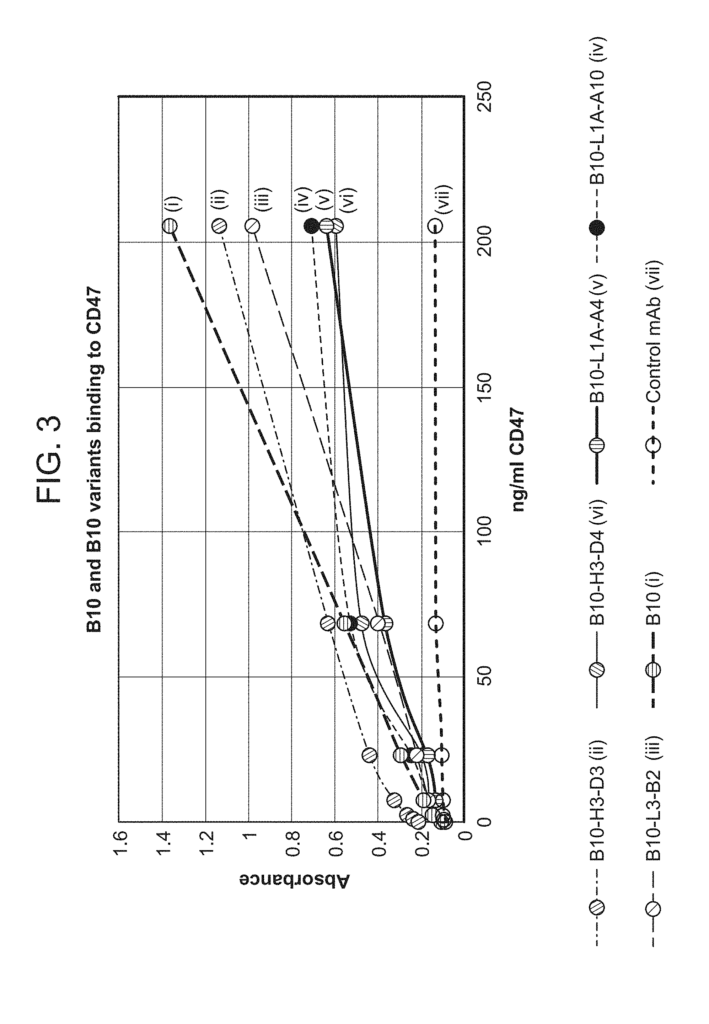
The present disclosure, in one aspect, provides an isolated anti-CD47 IgG antibody that binds a CD47 epitope at a binding affinity at least 10?6M. This antibody has a heavy domain variable sequence that is at minimum 95% identical to amino acid sequences chosen from the group of SEQID NO: 1, SEQID NO. The light chain variable sequence is at least 95% the same as the amino acid sequences selected from the group of SEQ NO 2, SEQ NO 4, SEQ NO 5, SEQ NO 6, SEQ NO 8, SEQ NO 15, SEQ NO 19, SEQ NO 20, SEQ NO 21, SEQ NO 23, SEQ NO 25, SEQ NO 26, SEQ NO 27, SEQ NO 28, SEQ NO 29, and SEQ NO 30. In one embodiment of the fully human antigen, both the heavy chain and the light chain are present. The antibody also has a heavy-chain/light-chain variable domain sequence that is selected from a group consisting SEQ ID No. 1/SEQ NO. 2 (C47A8) SEQ ID No. 1/SEQ NO. 4 (C47B10) SEQ ID No. 1/SEQ NO. 5 (C47B10-1H4S),SEQ ID No:1/SEQ NO:8(C47B10-1),SEQ ID N. SEQ ID NO. 6 (C47B10-1F6S),SEQ ID NO. 7/SEQ NO. 8 (C47B10-2A9S), ID SEQ. 9/SEQ NO. SEQ ID No. 8 (C47B10-2B11S) 10/SEQ NO. 4 (C47B10-2B8S), ID SEQ. 11/SEQ NO. SEQ ID No. 4 (C47B10-2C1S), 12/SEQ NO. 4 (C47B10-2B9S), ID SEQ. 13/SEQ NO. 4 (2C4S), ID SEQ. 14/SEQ NO. 15 (C47B10B1C), SEQID NO. 16/SEQ NO. 15 (C47B10-C6C herein), SEQ ID NO. 17/SEQ NO. SEQ ID No. 15 (C47B10D3C), 18/SEQ NO. 15 (C47B10 – C11C), SEQID NO. 19/SEQ NO. 15 (C47B10 – C11C), SEQID NO. SEQ ID NO. 20 (C47KD8) SEQ ID No. SEQ ID NO. SEQ NO.1/SEQ NO.8 (C47B10-1H4S2) 32/SEQ NO. 15 (C47B10 – C3C), SEQ NO. 1/SEQ I.D. “1/SEQID NO.
The present invention also provides an anti-CD47 fully human antibody fragment having a heavy and light chain variable domain regions, with the heavy chain sequence being at least 95% the same as the amino acid sequences chosen from the group of SEQ NO: 1, SEQ NO. The light chain has a variable domain sequence at least 95% similar to amino acid sequences selected from the group consisting of SEQ NO 2, SEQ NO 4, SEQ NO 5, SEQ NO 6, SEQ NO 8, SEQ NO 15, SEQ NO 19, SEQ NO 20, SEQ NO 21, SEQ NO 23, SEQ NO 25, SEQ NO 26, SEQ NO 27, SEQ NO 28, SEQ NO 29, and SEQ NO 30. In one embodiment, a fully human antibody Fab fraction has a heavy-chain variable domain and a lighter-chain variable domain. The antibody contains a heavy-chain/light-chain variable domain sequence that is selected from a group consisting SEQ ID No. 1/SEQ NO. SEQ ID No. SEQ ID NO. 4, SEQ NO. SEQ ID NO:1/SEQID NO:8 SEQ NO:5, SEQ NO:1/SEQ NO:8,SEQ NO. SEQ ID NO. SEQ ID No. 7, SEQ ID No. SEQ NO. 8 9, SEQ ID No. SEQ ID No. 8 SEQ ID NO. SEQ ID No. 11, SEQ ID No. SEQ ID No. 12, SEQ ID No. SEQ ID No. 13/SEQ NO. SEQ ID No. 14, SEQ ID No. 15 SEQ ID No. 16/SEQ NO. 15 SEQ ID No. 17, SEQ ID No. 15 SEQ ID No. 18/SEQ NO. SEQ ID No. 1/SEQID NO. SEQ ID No. 1/SEQ NO. 21, SEQ NO. SEQ ID NO. 22, SEQ NO:1/SEQ NO:8, SEQ NO. 32/SEQ NO. SEQ ID No. SEQ ID NO. “19, SEQ NO :22/SEQ NO :8,SEQ NO :1/SEQ NO :23,SEQ NO :24/SEQ NO :8,SEQ NO :1/SEQ NO :25,SEQ NO :1/SEQ NO :26,SEQ NO :1/SEQ NO :27,SEQ NO :1/SEQ NO :28,SEQ NO :1/SEQ NO :29 and SEQ NO :1/
The present disclosure also provides an anti-CD47 human single chain antibody with a variable region from a heavy and a lighter chain, and a peptide linking the heavy and light chains variable domain regions. 1, SEQ NO. 7, SEQ NO. SEQ ID No. SEQ ID No. SEQ ID No. SEQ NO. SEQ ID No. SEQ NO. SEQ NO. 16, SEQ ID No. 18 SEQ NO: 22, 24, and 32 SEQ NO. The light chain variable sequence is at least 95% the same as that of SEQ NO. SEQ ID No. SEQ NO. SEQ NO. 6, SEQ NO. SEQ ID No. SEQ NO. 19: SEQ NO. SEQ ID No. “21 SEQ NO: 23, 25 SEQ NO: 26, 26 SEQ NO: 27, 28 SEQ NO: 29, SEQ NO: 30, and SEQ NO: 30.
In one embodiment the fully human single-chain antibody has both a region of heavy chain variable and a region of light chain variable, wherein, the single chain fully humans antibody has a sequence for the heavy chain/lightchain variable domain selected from a group consisting SEQ ID No. 1/SEQ NO. 2, SEQ NO. SEQ ID NO. SEQ ID No. SEQ ID NO. 5, SEQ NO:1/SEQ NO:8 (C47B10-1), 1/SEQ NO. SEQ ID NO. SEQ ID No. 7, SEQ ID No. SEQ NO. 8 9, SEQ ID No. SEQ ID No. 8 SEQ ID NO. SEQ ID No. 11, SEQ ID No. SEQ ID No. 12, SEQ ID No. SEQ ID No. 13/SEQ NO. SEQ ID No. 14, SEQ ID No. 15 SEQ ID No. 16/SEQ NO. 15 SEQ ID No. 17, SEQ ID No. 15 SEQ ID No. 18/SEQ NO. 15 SEQ ID No. 19, SEQ ID No. SEQ ID No. 1/SEQID NO. SEQ ID No. 1/SEQ NO. SEQ ID No. SEQ ID NO. 22, SEQ NO:1/SEQ NO:8,SEQ NO. 32/SEQ NO. SEQ ID No. SEQ ID NO. “19, SEQ NO :22/SEQ NO :8,SEQ NO :1/SEQ NO :23,SEQ NO :24/SEQ NO :8,SEQ NO :1/SEQ NO :25,SEQ NO :1/SEQ NO :26,SEQ NO :1/SEQ NO :27,SEQ NO :1/SEQ NO :28,SEQ NO :1/SEQ NO :29 and SEQ NO :1/
Also, included in the invention is an anti-CD47 antigen-binding antibody or fragment, which contains a heavy-chain variable domain containing complementarity-determining regions (CDRs), as described in a heavy-chain variable region amino-acid sequence selected from a group consisting SEQ ID No. SEQ ID No. 7, SEQ NO. SEQ ID No. SEQ NO. SEQ ID No. SEQ NO. SEQ ID No. SEQ NO. 16, SEQ NO. 16, SEQ ID No. 18 SEQ NO: 22, 24, and 32 SEQ NO: 32 and a light-chain variable region containing CDRs, as described in an amino acid sequence for the light-chain variable region selected from a group consisting SEQ NO. SEQ ID No. SEQ NO. SEQ NO. SEQ NO. 8, SEQ NO. SEQ NO. 19: SEQ NO. SEQ ID No. “21 SEQ NO: 23, 25 SEQ NO: 26, 26 SEQ NO: 27, 28 SEQ NO: 29, SEQ NO: 30, and SEQ NO: 30.
The present disclosure also provides a method to treat a cancerous or fibrotic condition, which includes administering an anti CD47 polypeptide. This anti CD47 polypeptide can be selected from a group that includes an isolated fully human IgG antibody that binds CD47, and has a heavy-chain variable-domain and a lighter-chain variable-domain; an anti CD47 fully human Fab fragment that contains a heavier-chain variable-domain and a lighter-chain variable-domain; and “The present disclosure further provides a method for treating a cancer or fibrotic disease, said method comprising administering an anti-CD47 polypeptide. The anti-CD47 polypeptide is selected from the group consisting of Fab fragments containing corresponding heavy chain variable domains and light chains; a single chain human antibody containing corresponding heavy chain variable domains and light chains; wherein the heavy strand variable contains an amino acid sequence that is at least 95% identical to derived amino acids chosen from SEQ ID SEQ ID No. SEQ ID No. SEQ ID No. SEQ ID No. SEQ NO. SEQ ID No. SEQ NO. SEQ NO. 16, SEQ ID No. 18 SEQ NO: 22, 24, and 32 SEQ NO. The light chain variable sequence must be at least 95% the same as the amino acid sequence chosen from the group of SEQ NO. 2, SEQ NO. SEQ NO. SEQ NO. SEQ NO. SEQ ID No. SEQ NO. 19: SEQ NO. SEQ ID No. “21 SEQ NO: 23, 25 SEQ NO: 26, 26 SEQ NO: 27, 28 SEQ NO: 29, SEQ NO: 30, and SEQ NO: 30.
In certain embodiments the fully human antibodies or antibody fragments have both a heavy and light chain, wherein the antibody contains a heavy/light chain variable sequence that is selected from a group of SEQ ID No. 1/SEQID NO. SEQ ID No. SEQ ID NO. 4, SEQ NO. SEQ ID NO. 5, SEQ NO:1/SEQ NO:8 (C47B10-1),SEQ ID No. SEQ ID NO. 6, SEQ NO. 7, SEQ ID No. SEQ NO. 8 9, SEQ ID No. 8, SEQ NO. SEQ ID NO. SEQ ID No. 11, SEQ ID No. SEQ ID No. 12, SEQ ID No. SEQ ID No. 13/SEQ NO. SEQ ID No. 14, SEQ ID No. 15 SEQ ID No. 16/SEQ NO. 15 SEQ ID No. 17, SEQ ID No. 15 SEQ ID No. 18/SEQ NO. 15 SEQ ID No. 19, SEQ ID No. SEQ ID No. 1/SEQID NO. SEQ ID No. 1/SEQ NO. 21, SEQ NO. SEQ ID NO. SEQ NO:1/SEQ NO:8, 32/SEQ NO. SEQ ID No. SEQ ID NO. “19, SEQ NO : 22/SEQ NO : 8, SEQ NO : 24/SEQ NO : 8, SEQ NO : 1/SEQ NO : 23, SEQ NO : 1/SEQ NO : 25, SEQ NO :1/SEQ NO : 26, SEQ NO :1/SEQ NO :27,SEQ NO :1/SEQ NO :28,SEQ NO :1/SEQ NO :29 and SEQ NO :1/SEQ
In certain embodiments the antibody is IgG1 in isotype. Other embodiments use an IgG4 antibody.
In certain embodiments the anti-CD47 antigen-binding fraction or antibody described herein, is recombinant. In certain embodiments the antigen binding fragment or antibody described herein, is human.
The invention also provides pharmaceutical compositions containing an effective amount or anti-CD47 fragments or antibodies disclosed herein and a pharmaceutically accepted carrier.
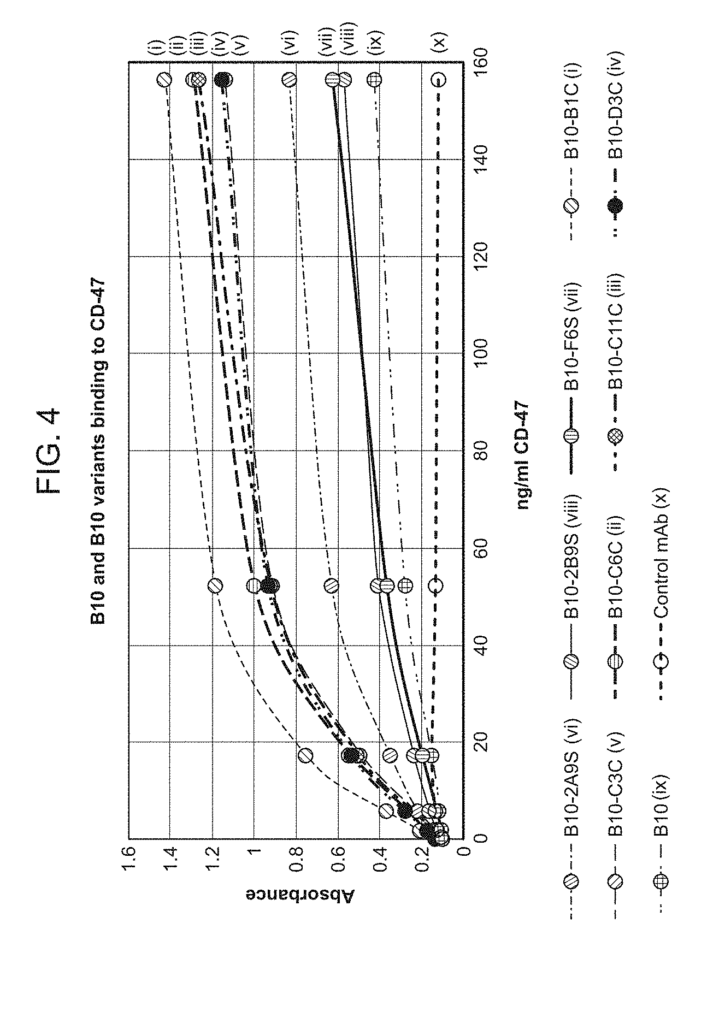
Click here to view the patent on Google Patents.
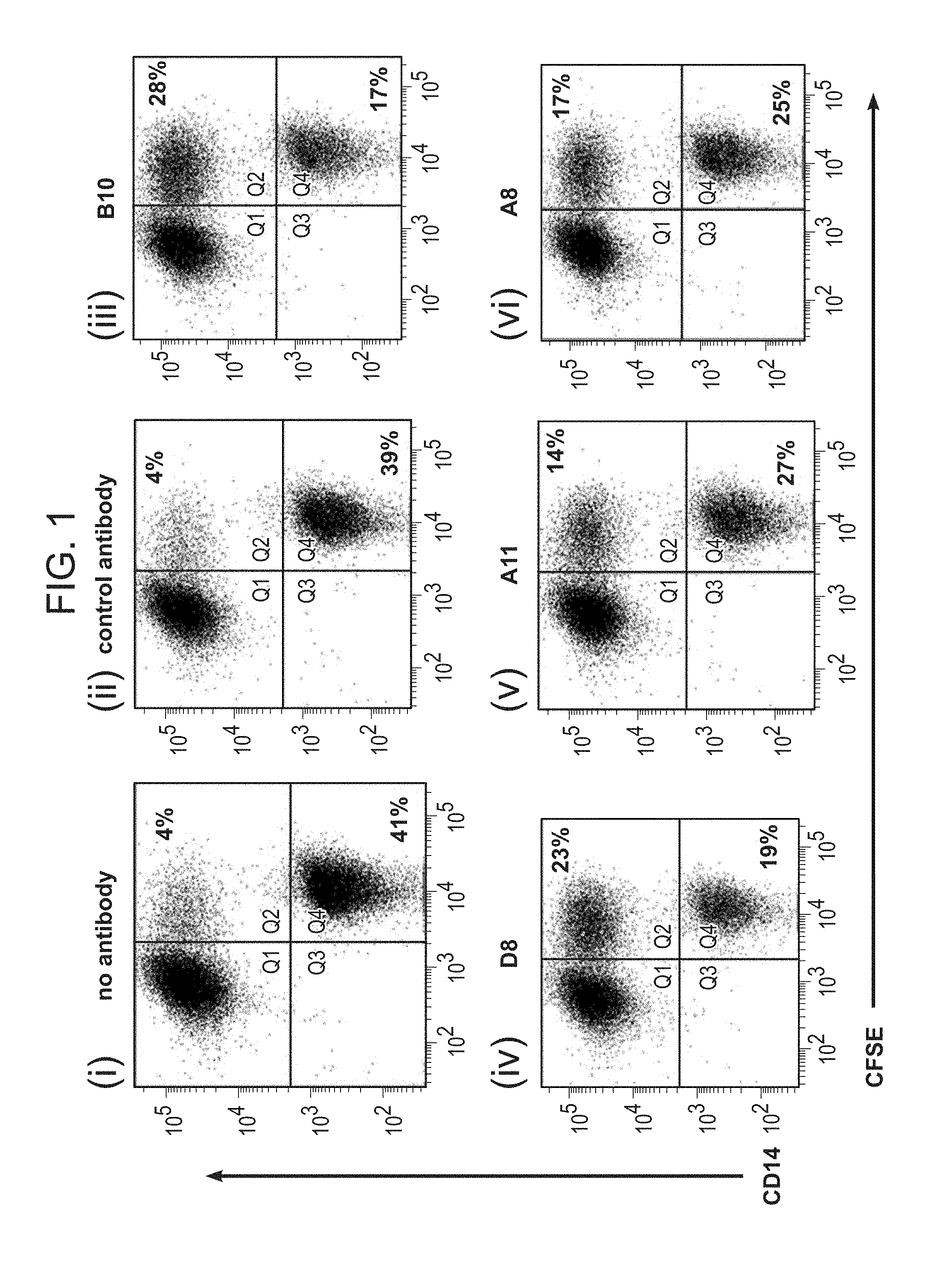
Leave a Reply